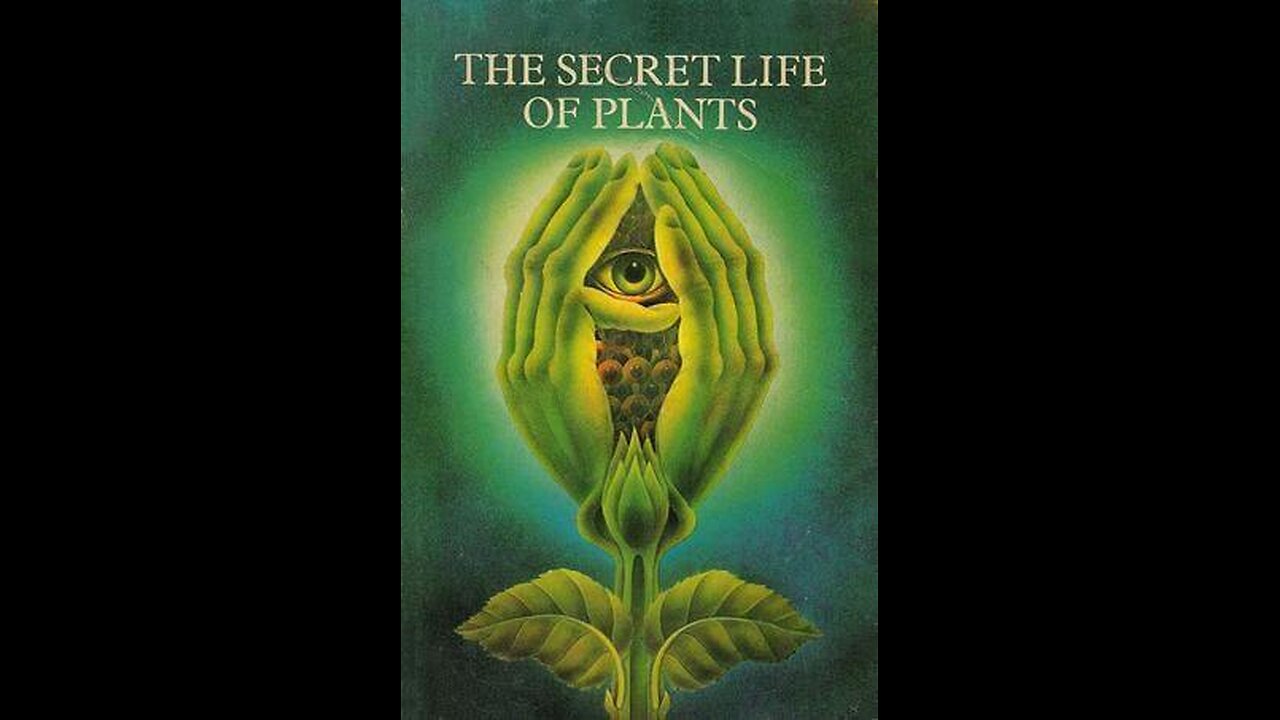Premium Only Content

The Secret Life Of Plants 1979 Documentary
Plants feel and communicate like people, but in their own way.
"The secret life of plants" is perhaps the best way to start learning about life.
It's a beautiful documentary but it is quite long which is sad for the valuable point it makes.
There is much more to learn about biology, the mind and it's abilities than "just" thinking, feeling and communicating plants.
The book "The Secret Life of Plants" was written by Peter Tompkins and Christopher Bird in 1973.
https://archive.org/details/TheSecretLifeOfPlants_201811/page/n235/mode/2up
Cleave Baxter wasn't credit for it, he actually did the work for the book and he came up with a lot of the current knowledge in lie detectors.
Some other interesting things he did which he couldn't report all of it, but was involved with people and what he did was took a mouthwash and took white blood cells from a persons mouth, and put that in a solution with electrodes so he got contact with them and monitored on a lie detector machine (EEG) readings from this white blood cell. At the same time put a traveling video camera on the person that they came from. Any time that something happened—this was a little bit different, Ill explain this one.
Any time something happened to that person that was emotionally stimulating whether it be fearful or on the other end of the spectrum, loving, it responded. It didn't matter how far away the person was either.
https://web.archive.org/web/20070704232208/http://www.psicounsel.com/radionics.htm
The secret life of plants
https://www.youtube.com/watch?v=wt3smrXkVpE
The Secret Life Of Plants (Nature Documentary) | Wild America | Real Wild
https://www.youtube.com/watch?v=w1lec-a_40Y
Seed to Seed, The Secret Life of Plants. (2006). By Nicholas Harberd
Plants Have Feelings Too
https://www.bbcearth.com/news/plants-have-feelings-too
The unbelievable ways plants use the same senses as humans.
Humans navigate their way through the world by relying on five basic senses: touch, sight, sound, smell, and taste. These senses help to build a picture of our surroundings, so that we can respond to any sudden changes. Many animals also rely on these senses to avoid being eaten, or to find food and safe shelter. But what about plants?
Plants can sense a lot about their environment and it can cause them stress. Unlike most humans and animals though, when plants face predation, damage, or environmental changes they can’t run away and hide.
Sessile – or stalkless – plants evolved to be incredibly sensitive to their environment in order to survive. Research into their awareness has revealed the incredible ways plants sense their environment: from "hearing" their predators, "smelling" their neighbours1and even "mimicking" the shapes of their plant hosts.
Touch
Climbing plants such as sweetpeas (Lathyrus odoratus) feel about for support to cling to,2 while other plants such as Arabidopsis (Arabidopsis thaliana) get stressed by touch, which stunts their growth.3 Many species use their roots to spread out through the soil, whilst avoiding rocks and toxic substances. Some plants even have specialised leaves to sense and respond to certain sensations. For example, sensitive plants (Mimosa pudica) have leaves that fold inwards when touched to prevent themselves from being damaged.4
Another great example is the Venus flytrap (Dionaea muscipula), which quickly snaps shut (as you’ll know if you’ve ever tickled one). Their traps are made up of modified leaves that are cleverly evolved to catch unsuspecting insects, while ignoring debris that falls in accidentally. The surface of these modified leaves are covered in miniscule trigger hairs. When a hair is touched, a chemical “timer” is set off within the leaf. Only when a second hair is touched within this time will the leaf close and begin digesting the prey caught inside. By requiring a second trigger, the leaves are adapted to tell apart live organisms from debris, ensuring they catch only what they need to survive.5
Sound
Up until recently, not much was known about how plants respond to different sounds, but researchers have demonstrated how plants not only “hear” nearby pollinators and predators, but also prepare themselves for a visit.
In 2014, Heidi Appel and Reginald Cocroft of the University of Missouri published a remarkable study.6 Using specialist equipment, they took recordings of caterpillars chewing on leaves and played them to unharmed Arabidopsis plants. Control plants were either played recordings of the wind, other non-predator insects, or nothing. Incredibly, plants exposed to the sound of chewing responded by producing the same defence chemicals they would release if they themselves were being chewed on.
More recently, a research group, led by Lilach Hadany of Tel Aviv University, discovered beach evening-primrose (Oenothera drummondii) was “listening out” for potential pollinators.7 When played the recording of a buzzing bee, the flowers increased the sugar content in their nectar, sweetening in anticipation. While there is no known mechanism used by plants to detect these sounds, it’s incredible to think about.
Taste and smell
Plants make their own food through photosynthesis, so they don’t have a need for the kind of taste that we recognise. However, taste and smell rely on the detection of chemicals by specialist receptors, meaning they are intimately linked. In the case of plants, they use a similar mechanism for a variety of important reasons, such as finding nutrients in the soil and avoiding rooting near toxic substances. Most incredibly, plants can also “sniff” out their neighbours and identify their relatives. Many tomato growers know the parasitic dodder vine (Cuscuta sp.), which locates and grows towards its host by sensing volatile chemicals lingering in the air.8
Below ground, plants are also communicating. By partnering with fungi, tree roots form large mycorrhizal networks with one another. Suzanne Simard studied these networks, finding nearly every tree in a forest was connected to the network.9 Trees use this network to pass carbon, nutrients, water, and even alarm signals to each other. Parent trees can also detect their saplings and send nutrients and water to them, ensuring their survival. It’s an essential lifeline to saplings growing in dark areas of the forest. Simard’s findings have important implications for forest ecology, demonstrating that forests are “more than just a collection of trees.”
Sight
While other animals rely largely on smell to navigate their environment, the most important human sense is arguably sight. Plants don’t “see” in a way that is recognisable to us, but they can detect many different forms of light, from ultraviolet through to infrared.10 One of the best-known examples of this is juvenile sunflowers (Helianthus sp.), which perform heliotropism; where the sunflower faces the sun to grow in the direction of the sunlight. Tracking the sun’s movement helps the plant to maximise the amount of sunlight they receive for photosynthesis.11
Boquila trifoliata is a fascinating climbing plant, native to Chile and Argentina. It is unique in that it appears to mimic the plant on which it grows, changing its leaf shape, size, colour, and even vein patterns. This science fiction behaviour was discovered by Ernesto Gianoli and Fernando Carrasco-Urra who hypothesised the Boquila camouflage in this way to avoid predation.12 It was suggested that Boquila can detect their hosts by their chemical signal – but in 2021, a paper was published demonstrating the Boquila is able to mimic artificial, plastic plants as well.13 While admittedly, the mechanisms for how Boquila mimics its host is entirely unknown, there is something fascinating happening in this unusual plant.
Plants get stressed, too
While we don’t know much about their sensory mechanisms, we do know they can be overstimulated and get stressed. Which begs the question, how do you calm a plant? In 1847, WF Clemens first reported that plants can be anaesthetised to lose their sensitivity in a way similar to humans and animals. More incredibly, when wounded or under attack by pathogens, plants produce their own anaesthetic compounds, which act to lessen their injuries.14
The plant experience, although seemingly inanimate, is complex and ever-changing. Whether they’re listening out for friend or foe, reaching out for family, building communities, or hiding from predators, plants are highly attuned to their environment and constantly reacting. Perhaps we’re not so different, after all.
original found on the wayback
https://archive.org/details/the-secret-life-of-plants_202204
-
 9:18
9:18
Watchman's Duty
18 days agoBuilding with Cob - A Natural & Affordable Way to Build a House
1.31K3 -
 3:01:07
3:01:07
TimcastIRL
9 hours agoCharlie Kirk Assassinated, Suspect In Custody | Timcast IRL
625K945 -
 5:44:49
5:44:49
Redacted News
11 hours agoTurning the Tide: 9/11 Justice in 2025 — Day 1 with Sen. Ron Johnson, Richard Gage and More
175K78 -
 2:48:00
2:48:00
TheSaltyCracker
9 hours agoYou're Being Hunted ReeEEStream 9-10-25
294K591 -
 13:09:56
13:09:56
LFA TV
22 hours agoBREAKING: CHARLIE KIRK ASSASSINATED - WEDNESDAY 9/10/25
378K127 -
 1:31:08
1:31:08
I_Came_With_Fire_Podcast
9 hours agoCheck Fire: God Bless Charlie Kirk
93.9K24 -
 1:13:35
1:13:35
Glenn Greenwald
11 hours agoCharlie Kirk Assassinated; NATO Alleges Russian Drones Flew Over Poland, and More | SYSTEM UPDATE #512
291K299 -
 1:46:28
1:46:28
Badlands Media
1 day agoAltered State S3 Ep. 45: The Assassination of Charlie Kirk
167K29 -
 8:56:53
8:56:53
Dr Disrespect
17 hours ago🔴LIVE - DR DISRESPECT - THE FINALS - NEW SEASON 8 LAUNCH EVENT W/ THE SHOTTY BOYS
285K11 -
 27:00
27:00
BonginoReport
12 hours agoRest In Peace Charlie Kirk - Nightly Scroll w/ Hayley Caronia (Ep.131) - 09/10/2025
265K413